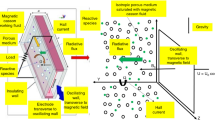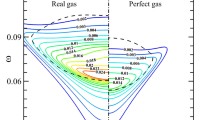Abstract
The paper considers the application of the Craft et al. [6]non-linear eddy-viscosity model to separating and impinging flows. The original formulation was found to lead to numerical instabilities when applied to flow separating from a sharp corner. An alternative formulation for the variation of the turbulent viscosity parameterc μ with strain rate is proposed which, together with a proposed improvement in the implementation of the non-linear model, removes this weakness. It does, however, lead to worse predictions in an impinging jet, and a further modification in the expression for c μ is proposed, which both retains the stability enhancements and improves the prediction of the stagnating flow. The Yap [24] algebraic length-scale correction term, included in the original model, is replaced with a differential form, developed from that proposed by Iacovides and Raisee [10]. This removes the need to prescribe the wall-distance, and is shown to lead to superior heat-transfer predictions in both an abrupt pipe flow and the axisymmetric impinging jet. One predictive weakness still, however, remains. The proposed model, in common with other near-wall models tested for the abrupt pipe expansion, returns a stronger dependence of Nusselt number on the Reynolds number than that indicated by the experimental data.
Similar content being viewed by others
References
Baughn, J.W., Yan, X. and Mesbah, M., The effect of Reynolds number on the heat transfer distribution from a flat plate to an impinging jet. In: ASME Winter Annual Meeting. ASME, New York (1992).
Cooper, D., Computation of momentum and heat transfer in a separated flow, using low-Reynolds-number linear and non-linear k-ε models. M. Res. Dissertation, Department of Mechanical Engineering, UMIST (1997).
Cooper, D., Jackson, D.C., Launder, B.E. and Liao, G.X., Impinging jet studies for turbulence model assessment: Part 1: Flow field experiments. Internat. J. Heat Mass Transfer 36 (1992) 2675-2684.
Craft, T.J., Prediction of heat transfer in turbulent stagnation flow with a new second moment closure. In: Proceedings 2nd Engineering Foundation Conference in Turbulent Heat Transfer, Manchester, U.K. (1998) pp. 4.15-4.25.
Craft, T.J., Graham, L.J.W. and Launder, B.E., Impinging jet studies for turbulence model assessment. Part II: An examination of the performance of four turbulence models. Internat. J. Heat Mass Transfer 36 (1993) 2685.
Craft, T.J., Launder, B.E. and Suga, K., Development and application of a cubic eddy-viscosity model of turbulence. Internat. J. Heat Fluid Flow 17 (1996) 108-115.
Durbin, P.A., Near-wall turbulence closure modeling without ‘damping functions’. Theoret. Comput. Fluid Dynamics 3 (1991) 1-13.
Durbin, P.A., On the k-3 stagnation point anomaly. Internat. J. Heat Fluid Flow 17 (1996) 89-90.
Gatski, T.B. and Speziale, C.G., On explicit algebraic stress models for complex turbulent flows. J. Fluid Mech. 254 (1993) 59-78.
Iacovides, H. and Raisee, M., Computation of flow and heat transfer in 2D rib roughened passages. In: Hanjalić, K. and Peeters, T. (eds), Proceedings of the Second International Symposium on Turbulence, Heat and Mass Transfer, Delft. Delft University Press (1997) Addendum pp. 21-30.
Iacovides, H. and Raisee, M., Recent progress in the computation of flow and heat transfer in internal cooling passages of gas-turbine blades. Internat. J. Heat Fluid Flow 20 (1999) 320-328.
Launder, B.E. and Sharma, B.I., Application of the energy-dissipation model of turbulence to the calculation of flow near a spinning disc. Lett. Heat Mass Transfer 1 (1974) 131-138.
Leonard, B.P., A stable and accurate convective modelling procedure based on quadratic upstream interpolation. Comput. Meth. Appl. Engrg. 19 (1979) 59-98.
Lumley, J.L., Toward a turbulent constitutive relation. J. Fluid Mech. 41 (1970) 413-434.
Myong, H.K. and Kasagi, N., Prediction of anisotropy of the near wall turbulence with an anisotropic low-Reynolds number k-ε turbulence model. ASME J. Fluids Engrg. 112 (1990) 521-524.
Nisizima, S. and Yoshizawa, A., Turbulent channel and Couette flows using an anisotropic k-ε model. AIAA J. 25 (1987) 414-420.
Patankar, S.V., Numerical Heat Transfer. McGraw-Hill, New York (1980).
Pope, S.B., A more general effective-viscosity hypothesis. J. Fluid Mech. 72 (1975) 331-340.
Raisee, M., Computation of flow and heat transfer through two-and three-dimensional rib-roughened passages. Ph.D. Thesis, University of Manchester Institute of Science and Technology (1999).
Rivlin, R., The relation between the flow of non-Newtonian fluids and turbulent Newtonian fluids. Quart. Appl. Math. 15 (1957) 212-215.
Shih, T.-H., Zhu, J. and Lumley, J.L., A realizable Reynolds stress algebraic equation model. Technical Report NASA Techn. Memo 105993, NASA Lewis Research Center (1993).
Suga, K., Development and application of a non-linear eddy viscosity model sensitized to stress and strain invariants. Ph.D. Thesis, Faculty of Technology, University of Manchester (1995).
Wolfshtein, M., The velocity and temperature distribution in one-dimensional flow with turbulence augmentation and pressure gradient. Internat. J. Heat Mass Transfer 12 (1969) 301-318.
Yap, C.R., Turbulent heat and momentum transfer in recirculating and impinging flows. Ph.D. Thesis, Faculty of Technology, University of Manchester (1987).
Author information
Authors and Affiliations
Rights and permissions
About this article
Cite this article
Craft, T., Iacovides, H. & Yoon, J. Progress in the Use of Non-Linear Two-Equation Models in the Computation of Convective Heat-Transfer in Impinging and Separated Flows. Flow, Turbulence and Combustion 63, 59–80 (2000). https://doi.org/10.1023/A:1009973923473
Issue Date:
DOI: https://doi.org/10.1023/A:1009973923473




